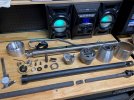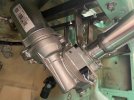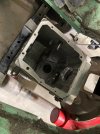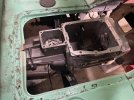Mach1 Driver
Well-Known Member
Yeah, if you continue the curve down and around on the lower extension that will look good.
Follow along with the video below to see how to install our site as a web app on your home screen.
Note: This feature may not be available in some browsers.
Hello there guest and Welcome to The #1 Classic Mustang forum!
To gain full access you must Register. Registration is free and it takes only a few moments to complete.
Already a member? Login here then!
Could you do a false floor? Like box it to hide the drive? If you run a "box" right across driver to passenger side it might not stand out once covered with carpet. If you had to, you could extend the box on the engine bay side for depth. Easy to put an access plate on there for maintenance. If if looks ok you could hide other things in there.So I'm out in the garage just adding to the list of independent little projects for the truck. I've got the underhood portion of the steering linkage all figured out and the parts in hand. Same for the inside the cab side including an Ididit style SS tilt column, a electric set-up out of an Equinox and some bits to connect the odd shafts of the GM unit to the wheel shaft and down to the front.
So here's the rub. I DO NOT WANT TO SEE the electric assist stuff. Just about every install I've seen has some or all of the drive hanging off the column in pretty plain sight. I get a little is likely necessary but I want to avoid it as much as I can. Here's what a stock column looks like. Just imagine wrapping an electric motor and gear box around that with it out in the open. Yuck.
View attachment 33766
So I needed a solution. A little thought and then internet search later and I have a plan. There is an aftermarket part rodders have been using in the tight confines of early hot rods that off sets the input and output heights of steering shafts which would do just what I want. Issue is they want like $650 for one! I've got everything I need to build my own on order now for about $200 and that was with some excess aluminum stock and a big chuck of UHMW that I will have left over for other projects. Here's the part I'm writing about.
View attachment 33767
Going this route will let me tuck the electric unit way up under the dash as I can run the column up against the dash lip, closer to horizontal to the floor, using the tilt function to give me the angle needed at the wheel. Then the offset piece can drop the out put shaft height low on the firewall to keep it out of your face underhood and in a good position to connect to the rack. I've always intended to make a lower dash extension to curve it back under like the top (if you look at that first interior pic above, this lower piece will come down about as far as that underdash gauge) which would have the hole through which the column would disappear.
Sorry, for being so long winded (what's new). Just wanted to lay out the plan while fresh in my mind. Thoughts?
Good thought. There is room but it would be right smack in your face. Pretty tight against the rear exhaust port as well, for my comfort. I thought about trying to hide it behind new bay panel structure but decided it would make things to "cramped" looking.Can you put the EPAS in the engine side of the firewall? Yeah, you'll be able to see it there, but just a thought out of the box.
Not really possible to change the floor layout. The pedal linkage and masters are hidden there now. Plus, the truck is equipped with air ride to drop it pretty low. Now putting the frame on the ground but low enough this set-up would not fit.Could you do a false floor? Like box it to hide the drive? If you run a "box" right across driver to passenger side it might not stand out once covered with carpet. If you had to, you could extend the box on the engine bay side for depth. Easy to put an access plate on there for maintenance. If if looks ok you could hide other things in there.
Just a thought
 will appreciate that I'm editing myself. So what got done? Primarily the steering column was modified to fit as needed and the electric assist assembly was mounted.
will appreciate that I'm editing myself. So what got done? Primarily the steering column was modified to fit as needed and the electric assist assembly was mounted.




You have no idea how much I cut from the first effort. Plenty of pics of the various parts being fabricated. Some basic but very useful tips on how to do things to, for example, make sure holes/studs will align perfectly when assembled. Some long winded explanation of how and why I built the upper support the way I did (hint: EPAS gear motors produce a lot of torque).I think you don’t understand the definition of “editing”
Mark





LMAOEveryone is always so fast to want to make more work for me. It's like having extra wives, I tell ya!
View attachment 33851
So here's the issue. If I leave the current crossmember and everything else as is the only way to service the trans or replace a clutch disc will be to pull the engine. The current crossmember is the mounting point for both the factory brake and clutch pedals as well as the underfloor master cylinder. I am keeping all of this in place. an alternative solution would be to make a new crossmember and locate it further back in the chassis but the location of the brake master cylinder would be right in the way. I can't see a good way around that issue.
I see two ways to go.
1. Cut the center section of the modified crossmember out and modify it all to make it bolt in. I'd also need to extend the factory floor cut-out just a bit to give the transmission room.
2. Extend the floor cut-out back to give the transmission room to move and the input shaft to clear the bellhousing but leave the crossmember complete. This would mean the trans/clutch servicing would happen from above. Pull it out the top!
I'm leaning hard to option 2. Why? The floor has to be opened up either way and this path leaves the crossmember in its most structurally sound condition. As the actual trans mount has to connect to the crossmember and be cantilevered out some 6" or so to the actual mounting point on the trans tailshaft housing, I think it the best for strength. Most importantly, I wouldn't be crawling around under the truck with a T5 on my chest!
Thoughts? Alternative ideas?